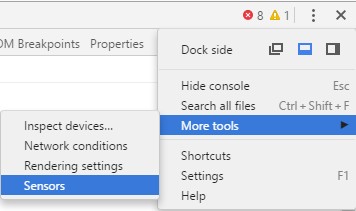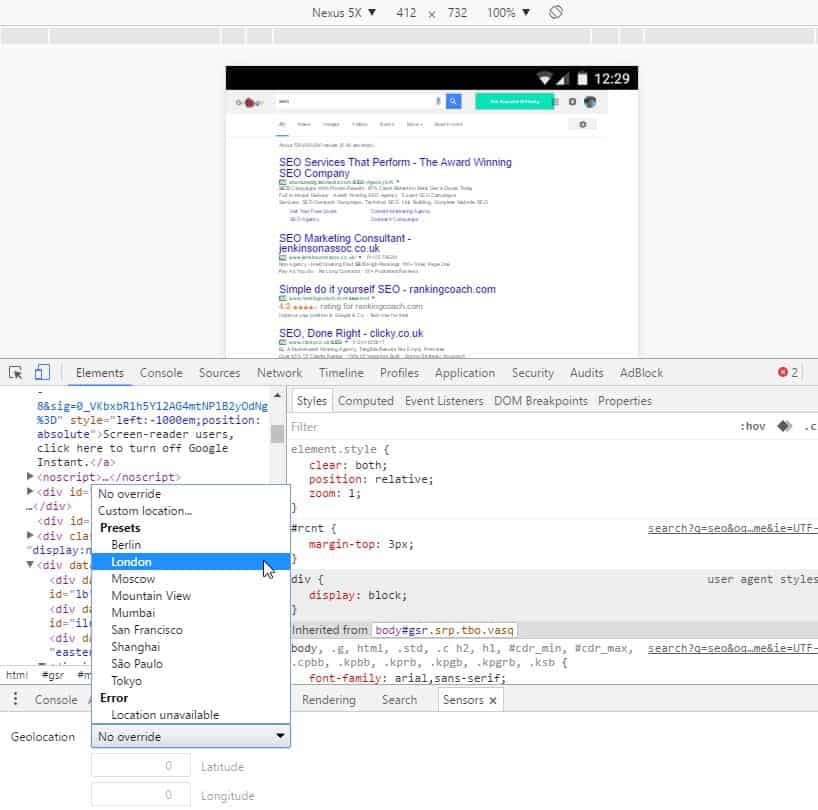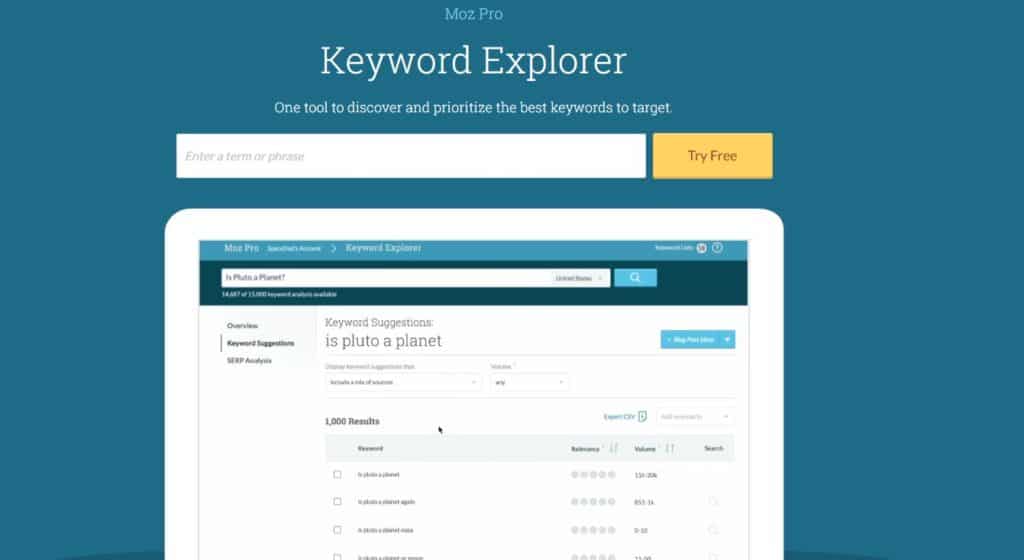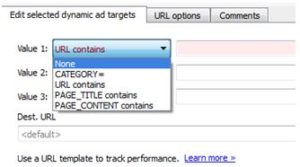Chrome’s developer tools are excellent and a must-use for SEOs. Here’s a quick run-through of the features we most regularly use:
How do I access Chrome developer tools?
Simple press F12 on your keyword or right-click on a page and select ‘inspect element‘ from the contextual menu. The benefit of inspect element is it immediately shows you information about the element on the page your pointer was on.
How do I change my location in Google searches?
Want to see a Google search result as if you were in a different city? Press F12 within a Google search page to access developer tools, then select the ‘sensors‘ tab in the bottommost menu. If you’re using developer tools for the first time you will probably have to add this menu: click the three-dot icon in the top-right of the developer bar > More tools > Sensors.
Once you’re in the sensor menu, you can select preset locations or enter latitude-longitude values to change your location to a specific point.
How do I emulate how a mobile phone browser sees a website?
It’s vital that your website is mobile friendly, and this method will let you see your site as if on a mobile browser. Press F12 in Chrome within a Google search page to access developer tools. Look for the mobile and tablet icon in the top-second-left of the developer bar and click it.
You can then select a preset mobile device resolution or other useful resolutions. Once you have selected your option press F5 to refresh and reload the page; it won’t appear correctly until you refresh.
You can also throttle the download speed to replicate the effect of downloading via a 3G or 4G network, and choose your user agent to replicate different mobile browsers on different devices (e.g. Chrome 52 on iPhone).
To throttle the network performance, select the ‘network conditions‘ tab in the bottommost menu and choose a throttling option. You can also select the user agent from this tab. If you’re using developer tools for the first time you will probably have to add this bottommost menu: click the three-dot icon in the top-right of the developer bar > More tools > Sensors.
How do I temporarily change colours and fonts on web pages?
Warning: you’ll need some understanding of CSS to properly implement this, but it’s great for previewing changes to site styling. Press F12 or right-click to get the ‘inspect element’ option. When in developer tools, look within the ‘styles‘ tab on the right-side box for a style you wish to change, such as a font, font size, font colour, or element colour. Simply click the value and type in a replacement to change it on the page instantly. You can view the styles of particular elements by clicking them within the left-side elements list.
You can also click the ‘computed‘ tab within the right-side box to more easily see what styles a particular element has inherited. Click the style within the computed tab and it’ll take you straight to the relevant style within the style tab, ready to be changed.
How do I check how quickly my website/page is loading?
Press F12 or right-click to get the ‘inspect element’ option and access developer tools. Navigate to the ‘timeline‘ tab in the main box. Follow the instruction and press F5 to evaluate and record load performance.
You’ll then provided with a recorded timeline of every load operation and the impact it has on overall page load speed.
You can combine this with the emulation of a mobile phone browser or data throttling described above to show the timeline of how a mobile device would download your webpage content.
The wizards of Moz (ha) are back again with an exciting new tool for we eager SEO’ers. Released back in May, the Keyword Explorer has been a long time coming and some even believe that it is the only keyword research tool you need. While we’re still in the experimental stages and are not quite ready to abandon our precious Google Keyword Planner quite yet, it’s definitely proving to lessen the time it takes to perform the sometimes massive task of keyword exploration. By taking you through discovery, gathering metrics, list building, filtering and prioritising – without even leaving the browser window as well as having the largest English-language online keyword database, we definitely feel like it’s a perfect place to start. It’s also good to note that already this program has not just been a one time launch, with constant ongoing work to update it, with the newest additions coming just a few weeks ago. As I said, we are still researching it’s benefits within our agency, but we do encourage all to give it a go, and with 2 free searches a day for non-Moz members, you’d be silly not to! Check out some of the exciting features and learn more about how you can use it within your organisation to help you to better understand the keywords you can target to attract customers to your site.
4 Key Indicators
When you first type in a term, you will receive results in a simplistic, easy to read page. Along the top of this page you will see 4 separate bar graphs detailing:
- Volume – the number of monthly searches for the keyword.
- Difficulty – how difficult it may be for you to rank against current competitors
- Opportunity – estimation of the click-through-rate in this search result. This also takes into consideration the number of SERP features (shopping ads, text ads, etc) that may bump your organic ranking further down the page.
- Potential – a combination of all the above metrics.
These are great as they really give you an excellent feel – just by a quick look – of how well using this keyword could benefit your campaign. Below these metrics, are 3 other boxes: Keyword Suggestions, SERP Analyisis, and Mentions. Mentions shows you a list of sites and links that include the chosen keyword (great for link building). Because Mentions takes you to a new tool, we’ll just focus on the two in-program features.
Keyword Suggestions
Here is where you can begin building your keyword list. Usual keyword research processes involve a variety of tasks in order to discover how people are searching for your site and tend to involve a variety of programs. It can even come down to you just simply typing a word into Google in order to see related or long-tail searches. Keyword Suggestions automatically gives you a list of 1,000 suggestions – an excellent amount to start with – and has already taken all of these other common programs we use into consideration. By using data collected from Keyword Planner, Google Suggest, Related searches as well as clickstream data, Moz has managed to build the largest English-language online keyword database thus cutting the time we would normally spend in many different programs down substantially.
You are also able to search for these keywords in a variety of ways if you’d like your lists to be more or less specific. These include:
- a mix of sources (default choice)
- only include keywords with all of the query terms
- exclude your query terms to get broader ideas
- based on closely related topics
- based on broadly related topics and synonyms
- related to keywords with similar results page
- questions
By searching using a combination of these options, you will be able to build a more robust keyword list. Once you view the results, you are able to filter via volume and relevancy as add selections to lists as you go.
SERP Analysis
If you’re curious to see what kind of competition certain keywords have, just select the keyword and head to the SERP Analysis. Here, you will be able to again view those 4 key indicators to give you an idea of the potential for that keyword, but also see the features that may get in the way of the top organic results (as in, if you can at least get on the first page, how many other features will people see before they see you!). Common SERP features include: Adwords, Knowledge Cards, Local Search Listings, Images, and Videos. While this function won’t show you the exact ads showing at that time, they will give you a more visual idea of the competition you’ll face if you choose to target that specific keyword. Below, you’ll see that searching digital marketing agency edinburgh shows 4x Adwords ads, and 3 local packs (usually including, contact information and images) before you even see the actual organic results! This means your organic listing, though it may be on the first page, may still be a bit of a scroll down the page. If you’re not bidding to show for one of those ads, it’s clear the competition may be too high and it might be better worth putting your money towards more specific terms.
Most of the time, building extensive keyword lists involves exporting and importing a variety of keywords to excel lists and hours of separating and filtering until you’re happy with your final list. With Keyword Explorer, while you are able to export and import lists and files as you wish, a lot of the separating and filtering can be done from within the browser window! Once your list has been compiled, you’ll be able to view overall metrics for the list (broken down into again, the same 4 indicators) as well as allowing you to filter even further by these metrics. When you’re finally happy with the way you list works, a simple download to .csv will allow you to share lists with coworkers or clients.
Other benefits and takeaways
We use Moz as a great learning resource around here, so it’s hard to say anything bad about this new offering. We’ve only had the opportunity to use it on one or two clients so far, and still haven’t given ourselves fully to its functionality but feel it really does a lot in regards to bringing all these different tools we used to use into one. We’re still a bit attached to Google’s Keyword Planner tools but definitely believe the Explorer has scope to assist us greatly going forward. Since launch, they’ve added a variety of extra features and have now expanded their keyword data to include international search outside of the US including UK, Canada and Australia. While it is still English-based, we have no doubt they’re continuing to work on growing the features they can offer and look forward to seeing where they’ll take it next!
Are you intrigued by this new product? Head over here, try a couple free keywords and let us know what you think? We’d love to hear your thoughts below!
Attacats Tim and Andrew were recently asked to go and speak at the New Media Breakfast in Edinburgh and Glasgow. (We love #nmbrek, they’re always filled with funky people doing interesting things!)
This week, Andrew and Tim went along to wax lyrical about all things PPC (Pay per click). They make loads of great points and we have done the hard job of picking out the best bits for you. Here’s the slide deck from the talks.
May’s New Media Breakfast is on Video and will take place in Edinburgh on 12th of May and in Glasgow on the 27th of May. Video is one of the biggest trends of 2016 and think it is increasingly becoming a major part of creative strategies – and something we are interested in learning more about!
Highlights
PPC has expanded way beyond search
PPC is not just about product searches anymore. It’s also about about using paid search to promote content. You can take a general subject and create interest before there is any buying intent. e.g. marathon running tips on a running shoe site. There are a lot more search queries for “marathon running tips” than for running shoes but by creating early interest, it means that you are at the top of their mind when they come to buy at a later stage.
PPC is not just about search. It is also about social, and because of their sophisticated targeting Facebook ads are leading the charge. The tracking of customers extends way beyond web activity. We all know that Google knows more about you than your Mum and it now tracks advertising back to sales that occur in store through your location settings. Scary for us mortals but the insight that this gives organisations over their PPC strategy is phenomenal.
The momentum is towards paid
Google is getting much better at commercialising any click as now they focus much more on “moments” as Google describes them as opposed to the search itself. Most of our time online is spent outside Google search – on Youtube, Twitter, Facebook the list goes on. PPC ads can now reach all of these.
Organizations have jumped on this band-wagon massively and have realised the value of using Paid Advertising to appeal to potential customers who haven’t yet developed intent. Complex, but lucrative.
Remarketing
Ever been followed all over the web to within an inch of your life, when all you have done is innocently look a pair of jeans?
Remarketing is a key part of the deal. Yes, it can be done badly (or annoyingly) but when done well it’s what’s going to keep you on the minds of your customers. By using it to link your content to your sales, it allows you to target customers who perhaps checked out your marathon tips and now want to come back for the shoes you’ve been placing throughout their web journey. Remarketing is not just about banner ads any more either. You can now remarket in search ads, shopping search ads,YouTube ads and ads across Social Networks, like Facebook, Instagram and Twitter.
 Automation
Automation
Not for the faint hearted but using 3rd party data to automatically change bidding strategies is producing great results. Automation in general is becoming a core part of paid search. Knowing when to automate and when not to automate has become a real skill. Not one to try at home.
PPC remains very cost effective
Yes, it is more competitive than it has ever been but PPC still drives results (we track £10 of revenue for every pound spent – on average).
There’s also a common perception that PPC budgets need to rival the levels of small country debt. Not true! Tim showed examples of a start-up spending the odd £100 here and there (as well as those generating more than a million pounds of revenue in a month). Facebook can help you create shareable content for people in the research phase who have been driven to the site for as little as a penny per visit!
In short it’s not about competing on budget size, it’s about being more relevant to your audience.
Would you like us to take a look at your AdWords or Facebook accounts?
A good few attendees have taken us up on our invitation to take a look at their PPC accounts. That offer is still open so please feel free to take us up on it.
Search engine marketing in all of its shapes is really all about space. How do you appear in the most attractive spots and how do you ensure that your brand occupies as much space as possible in the search results. Google announced a few months ago that they would remove the right hand side search ads on their search result page, triggering massive anxiety for PPC professionals worldwide. Would we see CPCs skyrocket? Would advertisers previously aiming for low ad positions be annihilated? The answer so far has pretty much been that not much has happened at all, at least not so far. That being said, there are definitely implications that needs to be considered for any PPC Manager. Instead of showing three search ads above the organic search results, there now are four. What this means in reality is that PPC ads now actually appear even more prominent than before on top of the search result page. This means that if you are aiming at top positions you need to make sure that you take full advantage of this space.
As most search ad extensions are only eligible to show when an ad is showing in top positions it is now more vital than ever to make sure that you have these in place and that you include as much information as possible. I will go through the different ad extensions below and explain how to best take full advantage of them.
Sitelink extensions
Sitelinks are by far the most important type of ad extension that AdWords offer. Why? Because they take up most space. According to Google, having sitelinks can boost your average CTR by 10-20%.
Consider the below example. In addition to the standard search ad, up to four sitelinks are eligible to appear, each with the same character limits for headlines and description lines as the standard ad.
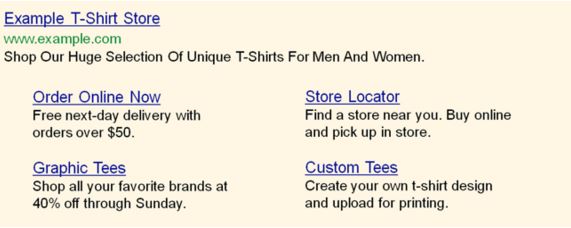
Studies have shown that the sitelinks themselves are actually not clicked that much, but simply having them there increases the click through rate of the ad significantly. It makes sense, after all, if you compare the above ad to a competitor ad without any sitelinks you are able to include so much more information with the sitelinks. If possible, it is strongly recommended that you include the two description lines in each sitelink, you can still get away with only the headline, but again that would mean less potential ad space used.
Callout extensions
Compared to the sitelinks that have been around for a long time, callouts are a new type of ad extension. They are non-clickable extensions with a character limit of 25. It is recommended to use this space to highlight additional USPs that you might not have had room for in the ad copy. Due to changes (and ongoing experiments) in the way that Google displays ads in top positions, callouts have recently taken on a vital role recently. Look at the ad below – the two description lines are merged into one, and the whole 2nd row are callouts! This is another example of Google actually increasing potential PPC ad exposure and a very clear indication that you need to add callouts now if you are not already using them.

Structured snippet extensions
An even more recent introduction to the ad extension toolbox, structured snippets require you to, hopefully, be able to fit your content into one of the categories as shown below.
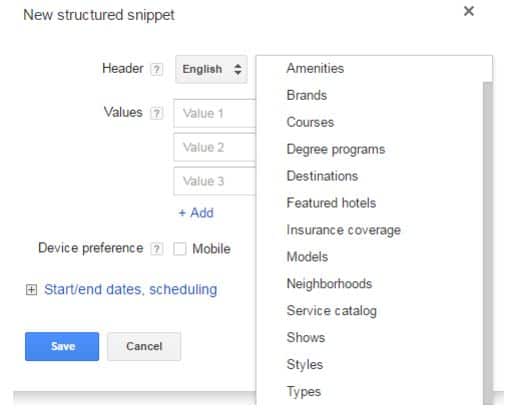
Similar to callout extensions, they are non-clickable and appear as a 2nd line of ad text.
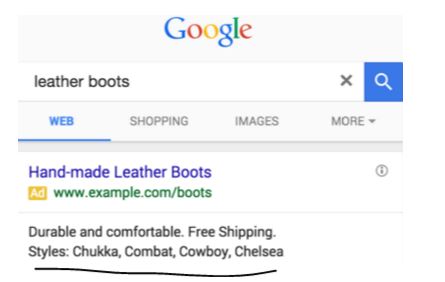
Review extensions
This extension allows you to quote positive reviews from third-party review websites. The exact source and URL needs to be specified in order for Google to authenticate the review before it can run. Again, this extension is eligible to show beneath the standard search ad or as a 2nd line of ad text if the two description lines are merged. This is a great opportunity to stand out if you are aiming at top positions and facing tough competition.
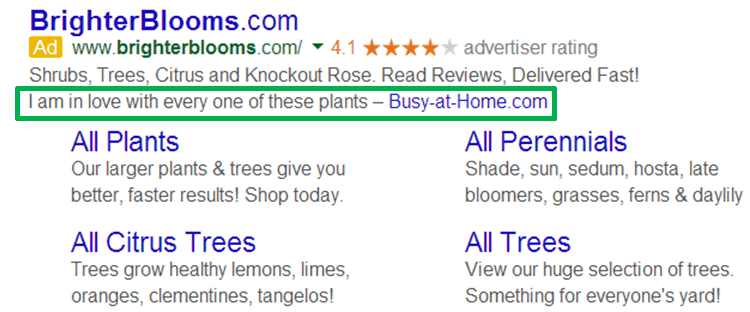
Location extensions
Location extensions are one of the oldest extensions around but still vital if you are advertising a physical location. You will need a Google My Business account setup in order to take advantage of this extension. If the extension is clicked on a desktop you will be shown the location on Google Maps. On a mobile, a click will give you directions (again on Google Maps) from your current location to the business location.

Call extensions
In terms of taking up space, call extensions are not on top of the list, at least not in the desktop version of the search results (where they usually appear at the right hand side of the display URL). However, it’s another story on mobile devices where, in addition to the standard call extension (simply showing the number), you will also get a “call” button, which will automatically generate a call when clicked.
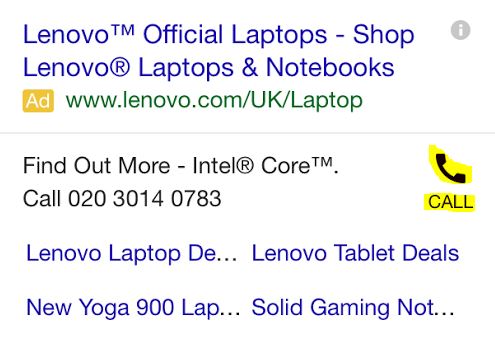
Conclusion
I would strongly recommend to add as many of these ad extensions to your ads as possible. In general, they do tend to increase click through rates and they will allow you to display so much more information than you can in a standard ad. Also, as mentioned, Google has been doing a lot of experimentation recently mixing and matching ad text with different types of ad extensions. If you can opt in to as many of the different ad/extension variations as possible, you might just be awarded with a higher quality score.
Follow all the #attamadness action live here
So we’re half way through our Leap Day Challenge and the #attamadness is real! Our Attacats have busy collecting supplier contacts, developing brand guidelines and building websites.
“THE #Attamadness IS REAL”
This morning the business idea was finally revealed to the Attacats. The concept is a UK-based comparison site for blown wood pellet deliveries! The website will work to provide biomass customers to compare prices, order and re-order fuel whilst understanding the direction of prices of biomass fuels. The initial focus of the business will be comparing prices of blown wood pellets acting as cheaper efficient fuel alternative. Were any of you able to guess the business idea from the clues?
After the briefing, the Attacats were unleashed to get to work in their teams, ready to take on the challenge of building this business in a day!
– Action from Attacat HQ –
The branding team swiftly took to naming the business and we had a name by 11am (It’s amazing what you can achieve when you put your mind to it) and thus… “The Woodpicker” was created.

– Danielle working on the logo –
The progress has continued at an impressive speed here at Attacat HQ with a primary website developed by Chelsey and Austin! We also have a phone number, a truly impressive logo (Thanks Danielle)!
Big thanks to Fresh Revolution for supplying our delicious lunch of pulled pork rolls and frittata and ensuring we’re fuelled for the rest of the day. Keep up to date with us on Twitter and Facebook where you can see us LIVE in action.
– Megan & Lily hard at work #SocialSquad –
You want to make your blog post look nice with an attractive image, so you go and grab one from Google image search or buy one from a stock photo site. Little do you know you could later be hit by a claim for hundreds, if not thousands, of pounds.
Disclaimer: I am not a lawyer nor legally trained. This post is intended to gather together experience from our team and further research. Neither I nor Attacat can be held responsible for any charges or issues incurred as a result of following the provided advice.
What is copyright?
Let’s start with the basics:
The legal right granted to an author, composer, playwright, publisher, or distributor to exclusive publication, production, sale, or distribution of a literary, musical, dramatic, or artistic work.
American Heritage® Dictionary of the English Language, Fifth Edition. (2011). Retrieved February 8 2016 from thefreedictionary.com/copyright
Copyright covers pretty much anything you might be outputting online:
- Code
- Photos
- Graphics
- Text
- Music
- Video
When might you get into trouble?
Copyright is granted automatically: if you create something you own the copyright. In very broad and basic terms that means you can’t help yourself to content unless you’ve been given specific permission.
Intellectual property law is struggling to deal with the internet somewhat, but it’s important that you always confirm whether you have the right to use any material in the way you intend.
People often wrongly assume they have permission to freely use copyrighted material or images, and in the following cases you probably don’t have permission:
 It’s on the web and seems to be ‘public’
It’s on the web and seems to be ‘public’- It’s in a press release or on a news site
- It’s within someone else’s product that you’ve bought (e.g images in wordpress theme, or in web design)
- There’s no copyright notice
- You’ve credited the source
- It’s an insignificant part of the work you’ve created
- There’s a creative commons license
- It’s a meme (a website was hit with a near $1000 claim after it used the socially-awkward penguin meme image)
- It’s on Wikipedia
- You paid the designer/photographer/developer for the work (unless you’ve got an explicit contract passing over the intellectual property rights)
- It was originally open source (additions are covered by copyright unless explicitly stated otherwise)
What are main types of copyright?
 Copyright
Copyright
All rights reserved: be extremely careful!
This means that the creator does not want to give up any of their rights under copyright law. Interestingly ‘all rights reserved’ is automatic so this is effectively the default position for creative works and generally doesn’t need to be stated.
Basically, don’t use it in any way unless you’ve clarified and purchased the rights to the material. Break this and you could be liable to incur significant penalty costs.
 Open Source
Open Source
No rights reserved (although it’s not that simple)
This more commonly applies to code and software; for images you’ll see CreativeCommons applied instead. As such I’m not going to really investigate this here.
 Creative Commons
Creative Commons
Some rights reserved: careful with licence!
Creativecommons.org explains that if you’re using Creative Commons content it always requires “accreditation in the form specified by the copyright owner”. Basically this means the copyright holder is making it available under certain circumstances: online this is normally – but not always – a link to author and another to the license, so that anybody who sees your use of the image can also see the copyright license.
Care is needed because there are different types of CC licenses, but excluding public domain works all require attribution.
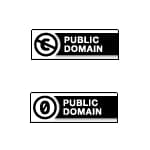 Public domain
Public domain
Copyright waived: use as you need!
Used if the holder of copyright or database rights has waived all interests in the work worldwide (CC0) or if a work is free of known copyright restrictions in all jurisdictions (public domain).
Public domain attribution can only be assigned by the original creator of the work, so if you’re not sure that is the case then do check with a lawyer.
Image from http://creativecommons.org/publicdomain/mark/1.0/ – modified to include both public domain buttons in one image. Licensed under a Creative Commons Attribution 4.0 International license.
You need to understand Creative Commons licences
Creative Commons can give you access to fantastic resources and images, but you must ensure that you only use them within the terms of the license that the creator has applied.
Attribution
![]()
The ‘loosest’ of the Creative Commons (CC) licenses, you can largely do what you want with these works as long as you appropriately credit the original:
- the name of the creator
- a copyright notice
- a license notice
- a disclaimer notice
- a link to the material
You must also must indicate if you modified the material and retain an indication of previous modifications.
You’re allowed to give credit and highlight changes in ‘any reasonable manner’ (nice legally loose wording!), but not in any way that suggests the licensor endorses your use of the work or you as a person/organisation.
OK for commercial use
ShareAlike
You can use and modify as you want as long as you credit the original and license any new creations under the exact same terms. Basically this forces works based on yours to carry the same CC license, and is notably used by Wikipedia.
Credit the original as per attribution licence
OK for commercial use
NoDerivs

You can use the work but it must be unchanged and contain the whole work (no derivatives).
Credit the original as per attribution licence
OK for commercial use
NonCommercial
You can use and modify as you want but only non-commercially (see definition of commercial usage below). Any new derivative works must also be non-commercial, but they don’t have to be licensed on the exact same terms.
Credit the original as per attribution licence
Non-commercial only
NonCommercial-ShareAlike

Similar to non-commercial but any new derivative works must be licensed under the identical terms of the original.
Credit the original as per attribution licence
Non-commercial only
NonCommercial-NoDerivs
The strictest of the main CC licenses, you must not modify works in any way and can only use non-commercially.
Credit the original as per attribution licence
Non-commercial only
What is commercial usage?
For most businesses or organisations the biggest risk is checking that a Creative Commons license allows for commercial use, defined as follows:
If you use content for general research, even if not for any specific purpose, and you or your organisation generates income, that counts as commercial use. So does using content for pro-bono work (from the Latin pro bono publico, meaning ‘for the public good’, or working for free), if it also enhances your reputation or leads to income-generating work in any way whatsoever.
source: Creative Commons: What is ‘commercial use’
Basically, if you’re using something for a company’s or your own website, blog or social media it’s almost certainly defined as commercial use.
 What is ‘fair use’?
What is ‘fair use’?
Fair dealing aka fair use is a tricky area. It’s there to ensure that works can be discussed, critiqued or parodied in controlled circumstances.
It is legal to use copyrighted material commercially without permission if (all) the following conditions are met:
- The amount of the material quoted or used is no more than is necessary
- The material quoted or used must be accompanied by some actual discussion or assessment
- You can use a work if you are reviewing it or critiquing it specifically (e.g. critiquing a photo)
- The source is credited appropriately (see Creative Commons ‘Attribution’ licence above for guidance).
You cannot use a work under fair use if just adding ‘colour’ or visual interest to your article or if reporting the work as news.
This is important: website owners you cannot take and use an image under fair use unless you are specifically critiquing or discussing the actual image.
What images are OK to use?
 Not sure what images you can use? It’s not easy, so if in doubt:
Not sure what images you can use? It’s not easy, so if in doubt:
- Images you’ve taken yourself depend on the situation. If you’re taking a picture of something that may be copyrighted, e.g. an event, then you can play safe and ask for permission to use.
- Images you’ve created yourself from scratch
- Images where you’ve checked the rights and meet them!
- Images that are CC0 / public domain
Sourcing images online
Buying stock images
If you buy images from a stock image site such as iStock or ShutterStock you must, without fail, check and confirm what usage rights you are purchasing, as each site may have different terms and license agreements. Most commonly when purchasing on an image-by-image basis you buy the right to use:
- Perpetually, so that there’s no end date on when you can use it.
- Non-exclusively, so anybody else can also buy the same image and use it. Hence the proliferation of that image of a dark-haired woman answering a call on a headset; the horror, the horror.
- Without limitation, meaning you can use an unlimited amount of times.
Generally, you’re not billed according to audience size and website views, but you may have to buy additional licenses if your ‘production budget’ is sufficiently high.
Different rules apply if:
- You buy something with a restricted license, so check!
- You buy any sort of subscription: you will often lose any rights to images you have purchased while in a subscription sometime after the subscription expires (normally 30 days). Subscriptions are therefore pretty risky unless you can absolutely guarantee you’ll be using that same image provider for eternity.
What is royalty-free?
This just means that you won’t be charged for every time you use the image, but you will still need to purchase the rights to use it. If you’re after free images be aware these are not free.
Where to find rights-free or creative commons images
 Pixabay is great for CC0 images.
Pixabay is great for CC0 images.- Morguefile seems to get free stuff from iStock and Getty Images, so double-double check the license!
- Gratisography has some quirky stuff.
- Sites like Unsplash and DeathtoStock add new photos periodically, but you can’t search so finding the right thing is a pain. They seem to get added to Pixabay though…
CreativeCommons
- Foter has a good selection of quality images.
- Do a Google advanced image search for commercial use images.
Will I get caught if I break copyright?
Do I have to pay?
 Be aware that if you are a commercial organisation that can afford to pay you are likely to be a target for claim actions if you are not fully compliant with copyright laws. The stock image sites, in particular, hire people to find their images that are unlawfully used, so it’s likely you’ll be found out at some point and you’ll have next-to-no legal recourse.
Be aware that if you are a commercial organisation that can afford to pay you are likely to be a target for claim actions if you are not fully compliant with copyright laws. The stock image sites, in particular, hire people to find their images that are unlawfully used, so it’s likely you’ll be found out at some point and you’ll have next-to-no legal recourse.
You’ll have to pay what would have been paid had licenses been sought in the first instance at the very minimum, but rights-holders can apply what seems an arbitrarily huge fee.
If you use an image without permission you are liable to be charged based upon a ‘rights-managed calculation’, where the fee can vary depending upon where you used the image or work. You’ll pay more for using it on a commercial website or blog, for example.
- You will be charged for each violation, so every image or work used will incur its own fee.
- Fees can easily
- Ignorance is not a defence: you will be held liable even if you made an ‘innocent mistake’.
- You need to get permission from the original rights-holder. If you used an image taken from somewhere/somebody else (even if they claim they have the rights) you will be held liable.
For example, if you linked to an article on another site from a ’roundup’ and used a image from their post in the roundup, you would need to own usage rights for that image.
How can I check my images are rights-free?
- Don’t use images that you aren’t sure about in the first place!
- Try a Google reverse image search. Just click on the camera image in the search bar shown in the image below, which I don’t think is particularly easy to find (see how I’m discussing and critiquing the image to justify fair use?). Upload your image and Google will show you where it’s been used online previously.
If you see any stock image sites like Getty Images, iStock, ShutterStock etc. then get rid of it quickly and HIDE!
In summary
Be careful. Organisations, particularly SMEs, don’t tend to think about image copyright until it comes back to bite them and by then it’s far, far too late.
AdWords dynamic search ads (DSAs) have been around for a while now, but I still get the impression that they are a PPC resource that is underused by a lot of PPC managers. The beauty of this campaign type is that, correctly used, it can serve a range of purposes in a PPC account. But let’s start from the beginning.
What is a DSA campaign?
When setting up a DSA campaign you need to specify what domain you are targeting, as AdWords actually uses Google organic search index to determine exactly what will be targeted. That’s right, a crossover between Googles paid and organic entities. As such, you need to take a few factors into account that normally would only really apply when you are working with SEO/organic rankings. The most important one is that if your site is not “crawlable” enough, DSA campaigns most likely won’t work at all. In other words, you need a very clear site structure, with subpages and URLs that are legible and make sense.

A DSA campaign does not use keywords like a standard search campaigns, instead you specify “values” or ”auto targets”, as shown in the below screenshot from AdWords Editor.
Why DSAs are so valuable to PPC managers
The ads used in DSA campaigns also differ from standard search ads, since the headline will be dynamically generated based on your targeting criteria.
If I am setting up a PPC account for a website that is well structured I usually always include a DSA campaign, and there is a good reason for it. As a PPC manager it is almost impossible to make sure that you cover all eligible keyword variations that someone might use. In a DSA campaign I can target a specific page and if AdWords detects that the search term used is relevant for the targeted page my DSA ad will be triggered, a headline will be populated, and maybe most importantly you will be able to see what search terms that triggered my ad in the search query report later.
This means that a DSA campaign can be really useful in the initial stages of a PPC account, because it allows you to discover potential keywords that people are actually using to click through to your website. These search terms can then be added as standard keywords and added as negative keywords in the DSA campaign.
Avoid duplication
To avoid competing against your own campaigns you should obviously make sure that you always exclude any exact match keywords that you are running in any standard campaigns before activating your DSA campaign. You also need to make sure that you have a very comprehensive negative keyword strategy in place. In a similar way to using keyword insertion in ad copies you might generate some strange headlines if you have not carefully reviewed the content of the targeted pages that you want to use.

If, for some reason, you are not seeing any traffic coming through your DSA campaigns there is a quick way of diagnosing if your targeting is eligible to pick up any traffic. In the AdWords interface, navigate to the campaign and click on “auto targets”. You should see the below view, which will show you how big your website coverage is for each ad target, if 0% you will need to amend your targeting criteria. One thing worth noting is that you need to wait 24 hours after creating the campaign before it will pick up any traffic.
Due to the organic targeting I have experienced different results with DSA campaigns in different accounts. There is also a certain degree of unpredictability that you need to get past. I have seen CPCs for high converting keywords being significantly lower in DSA campaigns than in standard search campaigns and I have also experienced some amazing conversion rates.
Google says yes
Google recently launched an update aimed towards a more efficient and easier target setup (you will now automatically get recommended categories to target based on what Google can detect on your targeted domain). This is a clear indication that this is a campaign type that Google believes strongly in for the future, and that means that you probably should get on board too!
UPDATE: Business Gateway has stopped accepting applications for the Digital Voucher Grant!
After what we believe was a very successful program from Business Gateway, we are saddened to pass on the news that they are no longer taking applications for the digital grant. With it being such a popular program, and with many of our now clients being able to take advantage, we do hope it is a program that is brought back soon. We’ll be sure to keep you up to date with any new happenings if they do!
_____________________________________________________________________________________________
We’ve heard a few mutterings about a digital marketing grant at various networking events this year but we’ve been unable to find any information online (it turns out that’s because there isn’t any). We decided to do a little more investigation and reached out to our contacts at various organisations. A few phone calls and one face-to-face meeting later and we’re finally in the know.
We can confirm that the lovely people over at Scottish Enterprise are currently offering a digital marketing grant of up to £5,000 which could potentially fund 75% of a project cost, so you can work to a project with a budget of up to £6666. This is incredibly good news for those that are eligible to apply.
Criteria
- Be registered with the Business Gateway in Scotland who will assess your eligibility for the scheme.
Unfortunately we’ve not been given any specifics on what eligibility looks like, but should you be turning over in excess of £70k per annum, or have the potential to do so, we feel you’ll have a good chance.
How to apply
- If you already have a Business Gateway advisor, please contact them directly and ask for an expression of interest (EOI) form for the Digital Scotland Voucher.
- If you do not currently have a relationship with Business Gateway then please contact Business Gateway Edinburgh on 0131 529 6644 or you can email bglothian@bgateway.com who will be happy to assist you.
The process, we’ve been assured, is nice and straightforward!

What can this huge grant be used for?
The voucher will provide a financial contribution of up to 75% of eligible costs to a maximum contribution of £5,000 to businesses to access consultancy and/or support implementation activities that introduce or enhance their Ecommerce, ICT or Digital Services capability.
Which Attacat services could the fund be used for?
- Strategy development – if you’re relatively new in the online world of business, a great place to start would be a strategy workshop. This will allow us to really get to know your business and understand who your target market really is. This information will become invaluable in any ongoing marketing activities, be it online or off. We have a number of exercises that we run through with clients to help them better understand their proposition and brand positioning.
- Training – we offer a range of training options with our most popular training sessions focusing on SEO, Paid Search and Web Analytics. We offer bespoke training sessions, to ensure that they are taking into consideration your existing knowledge base and objectives.
- SEO audit – a very popular service that allows us to analyse every aspect of your site and compare against best practice. We really get under the hood of your site and the output is a very beefy document that details all of our findings and also a snagging list which is essentially a list of things we would recommend changing and more detail on each item. An audit is a very good piece of work to undertake if you’re struggling to get anyway in the search results or you’re not performing as well as you used to. It is also a great way to learn more about SEO. Our audit documents detail what we’ve analysed, how it fairs against best practice, what we’d recommend changing and why. So you can certainly start to pick up some decent SEO knowledge.
- SEO consultancy
- New website/domain SEO considerations – another very popular service is what we’ve coined pre and post launch checks. If you are looking to move your website over to a new domain or indeed to a new design altogether, there are a lot of considerations that should be made from an SEO perspective. It is important that all aspects of the migration are carefully considered, especially in an attempt to retain your current rankings.
- Google Analytics customisation – do you find that Google Analytics out of the box isnt quite providing the level of data analysis that you require? Fear not, our trusty Analytics geek Chelsey is available for all of your customising needs. Analytics customisation can range from creating bespoke dashboards to setting up complex reporting. Let us know what you’re looking to achieve and we can formulate a plan of attack.
- Conversion rate optimisation – when it comes to your website’s conversion rate, it is important to never rest on your laurels. There are always things that you can change to help improve your conversion rate. We have a team of CRO experts on hand to help make this happen. From an in-depth conversion audit to ongoing testing, there’s always something that can be done to help improve your bottom line.
- Email marketing – we work with a number of firms to help improve their email marketing strategies, designing bespoke templates, improving data capture processes, introducing clever list segmentation strategies and ensuring that all aspects of a campaign are tested thoroughly so as to inform any future campaigns.
- Website design and build – is your website in need of a lick of paint or a complete overhaul? If so, £6,666 can certainly cover the cost of a brand spanking new website
and that is just a few suggestions. There really are are a whole host of different things that the we could work with you closely on that the grant would help to cover.
There are a few things that this grant cannot be used for…
- PPC click costs (such as Google AdWords or Facebook Ads)
- Hardware
- Staff costs
- On-going business
- Software as as service (SaaS)
- Off the shelf software
- VAT
If you feel you may be eligible and you’d be interested in discussing the opportunity further, please fill out this short form and a member of the Attacat team will give you a call…
We are constantly looking for new and innovative ways in which we can benefit our client’s businesses through their digital efforts. Yes, we’re particularly confident with SEO, PPC, CRO and Analytics amongst other channels, but this doesn’t mean we’re going to rest on our laurels. We’re an inquisitive bunch with a thirst for knowledge and a desire to be top of our digital games.
As such, we’ve always got our ear close to the ground to listen out for digital tremors that we feel are worth taking note of. One of these tremors has been occurring over the last couple of years more and more. I give you… Marketing Automation, Huzzah!
Marketing Automation is the utilisation of a software suite that enables you to scale personalised marketing communications. Essentially, marketing on steroids.

Marketing automation is a phrase that you may or may not have heard before, but you definitely need it in your digital vocabulary as of today. If you want to stay ahead of your competitors, then you really need to get smart about how you communicate with potential customers.
Advances in technology mean it is no longer effective to distribute a general marketing message to your entire audience, we need to get a lot more granular than that.
We will shortly be making a Marketing Automation software suite available to our clients, but what can you actually do with the software?
We’re certainly going to be implementing marketing automation techniques for the Attacat site (there’s a shiny all singing all dancing new website coming soon, stay tuned!) in the coming months. Here are a few examples of the wonderful things you can do with the software with specific Attacat-based examples:
- Personalised website content – By tracking how a user interacts with your website and indeed with your business as a whole, we are able to personalise a website to make it more tailored to each visitor’s needs. For example, if you are regularly looking at the PPC page on the Attacat site, we can safely assume that you are interested in PPC. We can then look to tailor our homepage to have more of a PPC focus. Or, we could provide different messaging to users we know have visited the site before. Getting super geeky, we could even have an overlay welcoming a specific client to the site.
- Ridiculously targeted email campaigns – You know how frustrating it can be to receive a super generic email newsletter or sales promotion that is not really that relevant to you or your purchasing behaviour. Frustrating emails result in unsubscribes and/or a negative opinion of your brand or business. Marketing Automation makes it possible to tailor your email messaging and content to what your customers are actually likely to want to receive. In the context of the Attacat site, looking again at the example of a user being particularly keen on PPC, we can ensure that all email communications have a strong PPC focus. We will of course want to talk about other channels, but we can ensure the focus is around the channel we know they are interested in. A really interested and effective feature of the software is being able to setup drip fed email campaigns. So this is the process of sending a different email at various intervals and the next email the user receives can vary based on what we know about that user’s interaction with the website or previous emails.
- Lead scoring – Certainly a feature that is more focused on B2B activity, but can be useful for B2C businesses too. Lead scoring allows you to prioritise your sales pipeline and reach out to the leads that are close to converting. Attribute scores for different actions or behaviours that we are able to track.
- Behaviour tracking – Know what web pages and other marketing touch points a user has interacted with and personalise your communications accordingly. We will be keeping track of all users who visit certain key pages. We will also be able to keep a note of who has attended various seminars that we’ve spoken at based on who downloads scripts/slides. Having this level of data will make our future communications much more informed. We’re also currently using the system to keep a track of who owns a priceless Attacat mug!
- CRM integration – Fully integratable with all well known CRM systems and even comes with its own built in CRM system. We have tried out various CRM systems in the past. The big players such as Salesforce as ridiculously expensive and so not justifiable (we’re a small agency!), and most of the small players were quite frankly crap. This system’s CRM is exactly what we need. Its simple, robust and best of all customisable.
- Sales analytics and optimisation – In order to understand what marketing efforts are working well and which not so well, you need to be able to attribute your sales back to the original touch point. Doing so will help you to understand the true ROI of different marketing techniques and strategies allowing you to optimise accordingly moving forward. Do more of what works well and less of what doesn’t. Simple stuff really, but you need the data to back up such decisions, and this software suite can help you gain that visibility. We are tracking our sales pipeline very carefully and can see very at a nice granular level where each new client has actually come from. We rank #1 for Edinburgh SEO and we’re on page one for SEO, so we tend to get a lot of leads through our prominent search rankings, but we also get a lot of people getting in touch who have heard good things said about us or they’ve seen us talking at a conference. Understanding each of these different routes to sale helps us understand what works well for Attacat. We can then tweaks our efforts moving forward.
- Anonymous visitor identification – A nice bonus feature that will be more tailored towards B2B users. Through reverse IP lookup, the suite can help you to identify which companies have visited your site, even if they’ve neglected to get in touch or identify themselves in any way. Creepy huh?
Marketing Automation helps you to really target all levels on the marketing funnel…
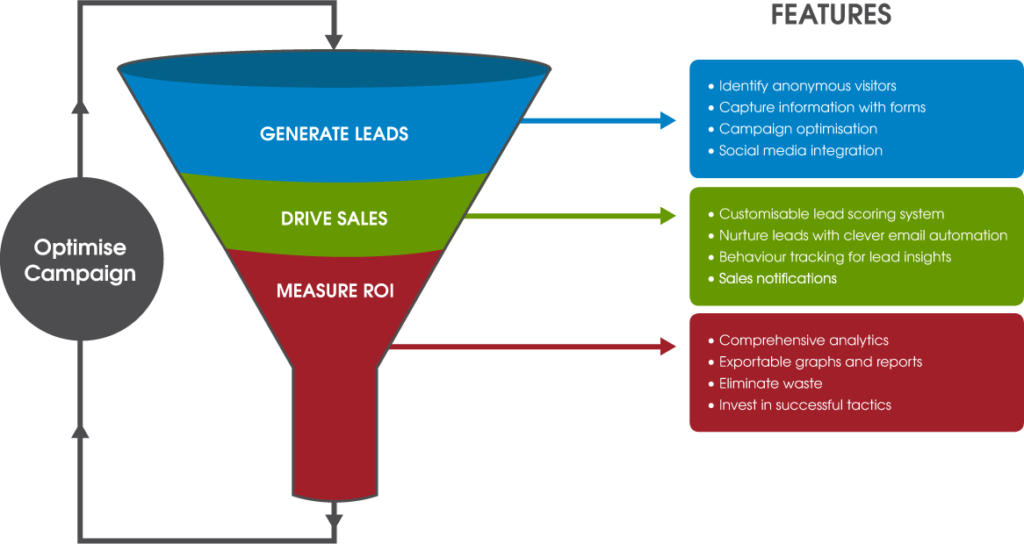
(click image to enlarge)
The biggest hurdle to getting started with Marketing Automation is generally the cost. The well known providers of such software are charging a really beefy monthly fee. Hubspot, arguable the market leader for automation, charge $800 per month for up to 1000 contacts. If your site receives even just a few hundred visitors a day, then this 1000 contact limit will be used up in a few days and you’ll find the software cant meet your needs effectively (without having to go up to the next price bracket). This poses a notable barrier to entry for a small to medium size business.
We’re currently in the process of finalising our automation offering and full details will of course be distributed shortly, but what we can promise, is that it will be affordable. Affordable for small business, but still with the robust and vast feature range that big business would like to utilise.
We just wanted to get you all excited about all the cool wonderful things we can do for you.
What ways would you like to automation your marketing processes? Leave us a comment to let us know 🙂 If you are interested in hearing more about our Marketing Automation service, please fill out the form below and I’ll be in touch extremely shortly! 🙂
